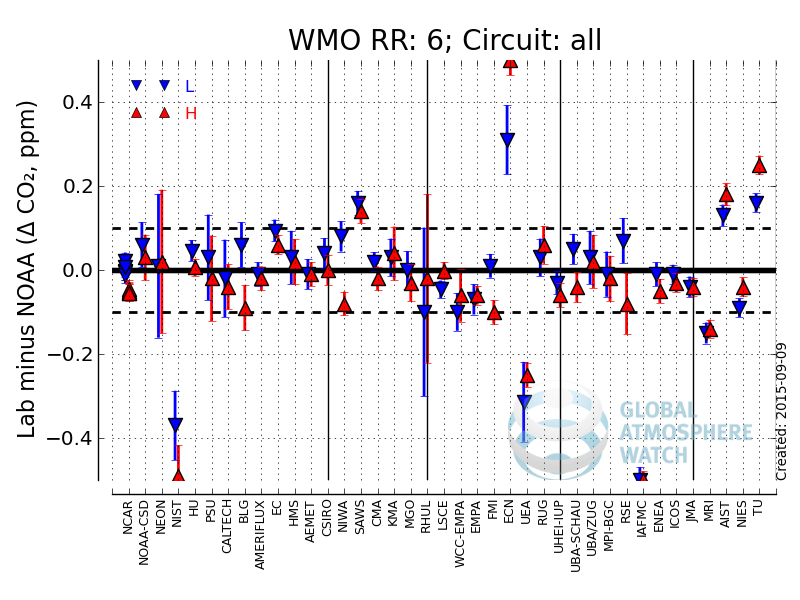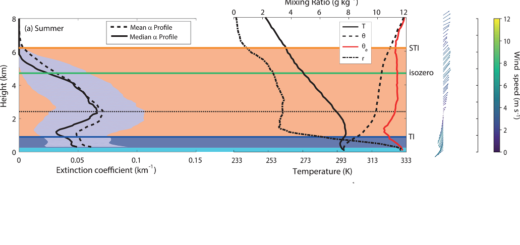Sixth WMO/IAEA Round Robin Comparison Experiment for Greenhouse Gases Measurements and Related Tracers
![]()

During 2014 and 2015 the Sixth WMO/IAEA Round Robin Comparison Experiment for Greenhouse Gases Measurements and Related Tracers was carried out, organized by the Earth System Research Laboratory of NOAA (The National Oceanic and Atmospheric Administration, USA), which acts as WMO Central Calibration Laboratory (CCL) for greenhouse gases. The Izaña Atmospheric Research Center (AEMET) participated in this intercomparison experiment, receiving in July 2015 two tanks of unknown concentrations and measuring intensively the air contained inside them to determine and report the concentrations of carbon dioxide (CO2), methane (CH4), nitrous oxide (N2O), sulphur hexafluoride (SF6) and carbon monoxide (CO). On 10 September 2015, the WMO CCL published the results of this intercomparison experiment (click here to go to the CCL webpage where the results are shown). AEMET (Izaña) obtained good results in general, being its result for the CO2 measurements excellent (see the plot that heads this page): the CO2 difference between the values assigned by AEMET to the tanks and those assigned by the WMO CCL is very close to cero, that is, the measurement results are almost identical and quite better than the WMO objective for this greenhouse gas.
The WMO GAW programme has very high accuracy goals for measuring atmospheric greenhouse gases. The reason is that the objective is not only to monitor the annual increases of the greenhouse gases and their seasonal cycles, but also to obtain the spatial distribution of the absorption and emission surface fluxes of these gases from the very small differences between the simultaneous measurements carried out in the different stations. The purpose is double: 1) understand better the greenhouse gases cycles to be able to predict in a more precise way their future evolution; 2) use the measurements to verify the emission inventories (and to reduce their uncertainty).
The very high accuracy goal of the GAW programme can not be obtained at all using instruments working in a commercial way, that is, instruments operated as their instruction manuals indicate. It is necessary to use complex techniques and measurement systems, the continuous use (e.g., every hour) of calibration standard gases (with traceability to the WMO primary standards), and process the instrument response raw data taking into account the hierarchy of calibrations. All the previous needs require developments by the institutions/laboratories that measure these gases. Additionally, there not exists a unique standard technique to measure each gas, but the use of different techniques and the continuous comparison between them is promoted to be sure that a very small mistake is not being made, which would prevent achieving the very demanding WMO accuracy goal. The present GAW accuracy goals are achievable for some of the gases with the techniques used at present, whereas for other gases the goal still can not be achieved. For example, the GAW goal for CO2 is achieving a measurement error smaller than 0.1 ppm of the Northern Hemisphere and 0.05 ppm for the Southern Hemisphere (because in the latter, the CO2 spatial gradients are smaller). Taking into account that the present CO2 mole fraction is around 400 ppm, this implies that the relative error in the CO2 measurement needs to be smaller than 0.025 % for the Northern Hemisphere and 0.013% for the Southern Hemisphere.
One of the most important intercomparison activities that WMO carries out with the purpose of quality control and assessment (among the laboratories that measure greenhouse gases), are the WMO/IAEA Round Robin Comparison Experiments for Greenhouse Gases Measurements and Related Tracers. In these experiments, the WMO CCL sends to all the participating Laboratories/Institutions a few high pressure tanks that contain standard air with unknown concentrations for the different greenhouse gases. The participants have to measure the air of these tanks and assign to them concentrations for the different greenhouse gases. All the participants report (in a private way using a web application) to the CCL (NOAA-ESRL-GMD) the concentrations they have measured. Once all the laboratories have measured these tanks, the CCL publishes the results and compares them with the values assigned by the CCL (which are the values used as reference, since the CCL maintains the WMO measurement scales for greenhouse gases).






